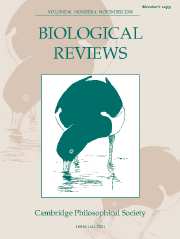Article contents
Coincidence, coevolution, or causation? DNA content, cell size, and the C-value enigma
Published online by Cambridge University Press: 27 March 2001
Abstract
Variation in DNA content has been largely ignored as a factor in evolution, particularly following the advent of sequence-based approaches to genomic analysis. The significant genome size diversity among organisms (more than 200 000-fold among eukaryotes) bears no relationship to organismal complexity and both the origins and reasons for the clearly non-random distribution of this variation remain unclear. Several theories have been proposed to explain this ‘C-value enigma’ (heretofore known as the ‘C-value paradox’), each of which can be described as either a ‘mutation pressure’ or ‘optimal DNA’ theory. Mutation pressure theories consider the large portion of non-coding DNA in eukaryotic genomes as either ‘junk’ or ‘selfish’ DNA and are important primarily in considerations of the origin of secondary DNA. Optimal DNA theories differ from mutation pressure theories by emphasizing the strong link between DNA content and cell and nuclear volumes. While mutation pressure theories generally explain this association with cell size as coincidental, the nucleoskeletal theory proposes a coevolutionary interaction between nuclear and cell volume, with DNA content adjusted adaptively following shifts in cell size. Each of these approaches to the C-value enigma is problematic for a variety of reasons and the preponderance of the available evidence instead favours the nucleotypic theory which postulates a causal link between bulk DNA amount and cell volume. Under this view, variation in DNA content is under direct selection via its impacts on cellular and organismal parameters. Until now, no satisfactory mechanism has been presented to explain this nucleotypic effect. However, recent advances in the study of cell cycle regulation suggest a possible ‘gene–nucleus interaction model’ which may account for it. The present article provides a detailed review of the debate surrounding the C-value enigma, the various theories proposed to explain it, and the evidence in favour of a causal connection between DNA content and cell size. In addition, a new model of nucleotypic influence is developed, along with suggestions for further empirical investigation. Finally, some evolutionary implications of genome size diversity are considered, and a broadening of the traditional ‘biological hierarchy’ is recommended.
Keywords
Information
- Type
- Review Article
- Information
- Copyright
- © Cambridge Philosophical Society 2001
- 380
- Cited by

